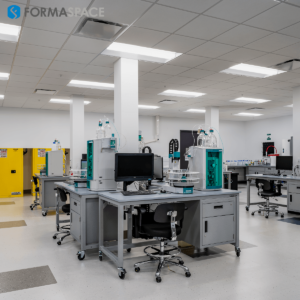More and more medical researchers are using big data to make medical discoveries. We take a look at key healthcare numbers in the headlines this week.
16 Million Electronic Records Possibly Linking Heartburn Medication to Heart Attacks
Last week we talked about how medical researchers are using Big Data techniques to investigate aggregated healthcare data. Later that day, researchers at Stanford University (a Formaspace customer by the way) reported that patients who take medication to suppress stomach acid are 16 to 21% more likely to have a heart attack.
By combing through more than 16 million electronic health records taken from 2.9 million patients, researchers were able to identify this data correlation, but the study does not prove a cause-and-effect. This category of heartburn medication, known as proton pump inhibitors, is one of the most used drugs in the world, with annual sales approaching $13 billion. Name brands of prescription and over-the-counter proton pump inhibitors include Nexium, Priolosec and Prevacid. The Stanford study did not find an association between heart attack and Zantac or Pepcid, both of which use a different mechanism to control heartburn.
How many Years Does it Take to Eliminate Trans Fat? 3 Years
Yesterday the Food and Drug Administration announced that the American food industry will have three years to eliminate artificial Trans Fats from the food supply. The agency estimates that this will prevent 20,000 heart attacks and 7,000 deaths from heart disease annually. Specifically, the FDA has rescinded the so-called GRAS status for partially hydrogenated oils, the source of Trans Fats.
GRAS stands for “generally recognized as safe”. Without GRAS status, food ingredients must be proven to be safe, which is a very high hurdle in this case, given the extensive evidence linking Trans Fats to coronary heart disease. This change is a major victory for Fred A. Kummerow, the 100-year-old University of Illinois professor who has been leading the charge to alert the public about the dangers of artery clogging Trans Fats since the 1950s.

1.75 Million Patient Study Uncovers Relationship Between Birth Month and Disease
Do you believe in astrology? Scientists dismiss astrology as pseudoscience. However, a Big Data research project analyzing a staggering 1.75 million patients who received treatment at Columbia University Medical Center found 55 diseases that correlated with the patient’s month of birth. 1,633 diseases showed no correlation. But the list of 55 that did include serious medical conditions, such as ADHD, asthma, eyesight, ear infections and reproductive issues.
The scope of the study was enormous, 1.75 million patients born between 1900 and 2000. Most of them were residents of New York City, so environmental factors affecting this cohort could be quite different from a patient study conducted in a Midwest farming state. Nonetheless, the results are very interesting. October and November births were associated with higher risk of disease related to respiratory, reproductive and neurological illnesses. Those born in January to June had higher risk of cardiovascular disease.
Researchers are considering the implications of the study. For example, there’s a link between exposure to dust mites in the first three months and contracting asthma. The dust mite life-cycle changes throughout the year, which could be responsible for some of the results. Research has also confirmed an upward trend in ADHD diagnoses among births occurring in the latter half of the year, with November having the highest number.

How Many Steps Do You Need a Day to Stay Fit? 10,000
If you are of a certain age, you may remember clunky old metal pedometers you clipped to your belt. Now re-branded as Fitness Trackers, these modern personal health devices measure how many calories you burn and the distance you’ve traveled. It’s big business too. Fitbit, one of the leading manufacturers, is set to go public. Research firm IDC estimates the market will expand to 100 million devices sold around the world by 2019.
If you haven’t already caught up with the fitness tracker craze, you may find yourself getting encouragement from the Human Resources Department at work. Many employers encourage their staff to wear the devices to promote good health. Interestingly, the global “step culture” has coalesced around a big round number for the number of steps each of us should take every day: 10,000 steps. This number is actually little bit higher than health experts around the world had previously recommended. But getting in more exercise is a good idea.
How Many Appendicitis Cases are Diagnosed Each Year in the U.S.? 300,000
One in ten of us will have appendicitis during our lifetime. Surgery has been the standard treatment for appendicitis for over 100 years. Now Finnish researchers have announced that intensive antibiotic treatments for patients with uncomplicated appendicitis is a viable alternative for routine appendectomy surgery. Finnish doctors used CT scans on patients to exclude those with complicated cases, such as perforated appendices.
Those patients who passed the CT scan criteria were given a course of antibiotics. Three out of four recovered easily with no residual pain. Those that did not recover from antibiotics alone went on to have surgery and had no residual effects from attempting the antibiotic only treatment first. “The time has come to consider abandoning routine appendectomy for patients with uncomplicated appendicitis,” said Dr. Edward H. Livingston, a surgeon and editor at the journal JAMA, which published the study.
What is the Annual Healthcare Spending on Unnecessary Procedures? $600 Billion
According to a report released this week by Johns Hopkins University School of Medicine and the Johns Hopkins Bloomberg School of Public Health, 30% of all healthcare spending nationwide — roughly $600 billion annually — could be eliminated without a decrease in health care quality. By investigating Medicare fee-for-service claims for more than 1.2 million patients over age 65, researchers determined that lower rates of coordinated health care services are associated with higher rates of unnecessary medical tests and procedures.
Each year, according to lead study author Max Romano, M.D., M.P.H., the average Medicare patient makes 13 medical visits in four different practices, split among an average of two primary care physicians and five specialists. “The scale of overuse is mind-boggling,” says Romano. “Unfortunately, patients just don’t know which procedures are necessary and which aren’t. They have to put a lot of trust in the health care system and providers. The fragmented health care system may make it harder for their providers to make the best decisions.”
What is the Cost of 5 Years of Obamacare? $506 Billion
Congressional Budget Office projection for the cost of Obamacare between 2015 and 2019 is $506 billion. There’s some good news in this month’s new report. The latest estimates are down by $142 billion over the coming 10 years. The main reason for the lower estimate is health insurance premiums are rising more slowly than expected. Also helpful is that slightly fewer people are signing up for Medicaid and for subsidized insurance than projected. Finally, health insurance coverage by employers was higher than anticipated and fewer companies are canceling insurance coverage for their employees than projected.
What are the Medicare Prescription Drug Benefit Savings? $0
On the other hand, the Congressional Budget Office now estimates that Medicare Part D, which helps provide prescription medications for seniors, does not save money in the long run. When it was enacted in 2003 as part of the Medicare Modernization Act, an assumption was made that having better drug coverage would lead to better health outcomes, and in turn lead to lower health care costs. Researcher Becky Briesacher from the School of Pharmacy at Northeastern University concludes in a new study that Medicare Part D did not see the program save any money overall. But we feel it’s still important that seniors live healthy lives.
Formaspace Supports Healthcare and Life Sciences
We invite you to join the roster of satisfied Formaspace technical, manufacturing and laboratory furniture clients — including Apple Computer, Boeing, Dell, Eli Lilly, Exxon Mobile, Ford, General

Electric, Intel, Lockheed Martin, Medtronic, NASA, Novartis, Stanford University, Toyota and more.
Give us a call today at 800.251.1505 to find out more about the Formaspace line of built-to-order computer workstations, industrial workbenches, laboratory furniture, lab benches and dry lab/wet labs — as well as our design / furniture consulting services. Like all Formaspace furniture, it’s backed by our famous 12 year, three shift guarantee.









